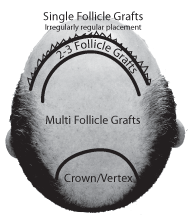Designing a Hairline for Hair Restoration
Well placed grafts will result in a natural appearing hairline. Transplanted hair must not only approximate the outline of the natural hairline, but it must also approximate the angle of the natural hair. When making the recipient sites, a surgeon must be aware of the angle of the hair with the scalp and direction of the natural hair and how it changes over portions of the scalp. For instance, at the front of the scalp, hair is angled forward, while in the temple and sideburns it is angled down. The number of follicles per graft placed in the recipient site is also important to maintain a naturally appearing hairline. Individual follicles placed in a random pattern are used to define the edge of the hairline. Slightly back from the edge, 2-3 follicle grafts are used for added coverage. Beyond this, 1-5 follicle grafts may be safely used to increase hair density and cover a balding area.
Hair Restoration For The Crown
Recreation of a bald crown of the head is a bit more challenging. The crown of the head has significant variation in the angle of the hair. The surgeon must be keenly aware of the varying angulation of this area when recreating the hairline or an unnatural appearance will most certainly result. Most grafts placed in this area are single are at most 2-3 follicle grafts.
For adding density at the top of the head, small squares are created to ensure even distribution of the transplanted hairs. The size and density of each square will depend on a patient’s remaining hair density, the number of grafts to be transplanted in the current session, and the size of the area of concern. For a hair transplant hairline to look natural, these subdivisions will often encompass a small strip along the hairline to ensure adequate density.
Follicular Unit Transplantation
In one session of a follicular unit transplant, 500 to 3,000 or more grafts may be placed. Alternately, several sessions may be necessary to obtain the desired result. While one large session can be performed in cases of severe hair loss, multiple smaller sessions may be preferred. Research indicates that graft survival decreases with increasing time out of the body. Larger sessions will necessarily require more time out of the body for grafts and therefore decrease survival. In addition, patients must remember that the donor site is a non-renewable resource – once it is used, it is gone. Should a disastrous outcome or complication occur and a significant part of the donor is used with one megasession there may be little to none left to repair the damage.
All photos are models unless otherwise noted. (c) 2017. All rights reserved.


